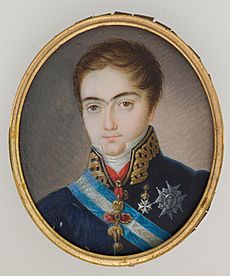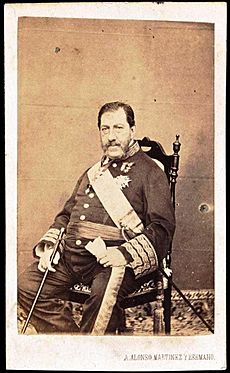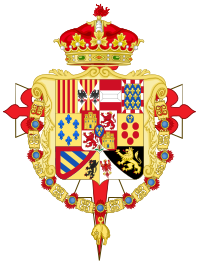Infante Francisco de Paula of Spain facts for kids
Quick facts for kids Infante Francisco de Paula |
|||||
|---|---|---|---|---|---|
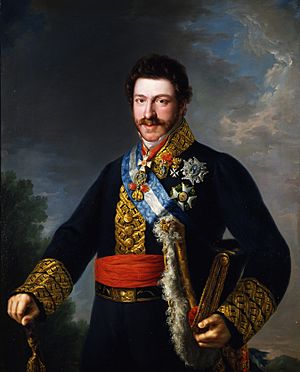
Portrait by Bernardo López Piquer
|
|||||
| Born | 10 March 1794 Aranjuez, Spain |
||||
| Died | 13 August 1865 (aged 71) Madrid, Spain |
||||
| Burial | El Escorial | ||||
| Spouse |
Princess Luisa Carlotta of Naples and Sicily
(m. 1819; died 1844)Teresa de Arredondo y Ramirez de Arellano
(m. 1852; died 1863) |
||||
| Issue more... |
|
||||
|
|||||
| House | Bourbon-Anjou | ||||
| Father | Charles IV of Spain | ||||
| Mother | Maria Luisa of Parma | ||||
Infante Francisco de Paula of Spain (born March 10, 1794 – died August 13, 1865) was a Spanish prince. He was the youngest son of King Charles IV of Spain and Queen Maria Luisa of Parma. He was also the brother of King Ferdinand VII. Later, he became the uncle and father-in-law of Queen Isabella II.
Francisco de Paula's education was interrupted by the Napoleonic Wars in Spain. When he left Spain in May 1808 at age fourteen, it caused a popular uprising in Madrid. This rebellion was put down by French soldiers. For the next ten years, Francisco de Paula lived in other countries with his parents, first in Marseille and then in Rome.
He returned to Spain in 1818. His eldest brother, King Ferdinand VII, gave him many honors. Francisco was interested in art, and he was a singer and painter. In 1819, he married his niece, Princess Luisa Carlotta of Naples and Sicily. She was the oldest daughter of his sister Maria Isabella. They had eleven children. Luisa Carlotta played a big part in making sure Ferdinand VII's daughter, Isabella II, would become queen.
During Queen Isabella II's early reign, Francisco was not allowed to be part of the government. He and his wife sided with the liberals. They became active in opposing the government and had to move to France in 1838. They came back to Spain later but were exiled again for conspiring against the new leader.
When Queen Isabella II officially became old enough to rule, they returned for good. Francisco and his wife hoped their oldest son, Francisco de Asis, would marry Queen Isabella II. Luisa Carlotta died in 1844. But in October 1846, Isabella II married Francisco de Asis. As the Queen's father-in-law, Francisco de Paula had an important role at court. He died in 1865.
Contents
Early Life of Francisco de Paula
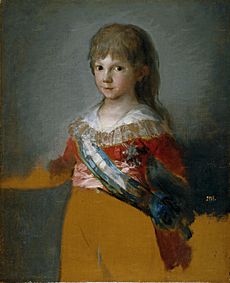
Francisco de Paula was born on March 10, 1794. He was born at the Royal Palace of Aranjuez in Spain. He was the fourteenth child of King Carlos IV of Spain and Queen Maria Luisa of Parma. He was given the full name Francisco de Paula Antonio Maria.
His parents had been married for 29 years, and he was their last child. As the youngest, he was his mother's favorite. His father, King Carlos IV, loved hunting and collecting clocks. He was not very interested in ruling his kingdom. He let his wife and his prime minister, Manuel Godoy, handle the government.
When Francisco de Paula was a child, he had blond hair and brown eyes. In 1800, at age six, he was painted with his family by Francisco Goya. This famous painting is called Charles IV of Spain and His Family.
Francisco de Paula's education was different from his older brothers. His parents wanted him to join the Spanish Navy. However, his schooling stopped suddenly because of the Napoleonic Wars in Spain.
Napoleon invited King Charles IV and his eldest son, Ferdinand VII, to a meeting in Bayonne, France. Napoleon wanted them to give up the Spanish crown to him. After they did, Napoleon gave Spain to his brother Joseph Bonaparte. He then ordered the rest of the Spanish royal family to leave the country.
Francisco de Paula, who was fourteen, stayed at the Royal Palace of Madrid. On May 2, 1808, a crowd gathered outside the palace. They wanted to stop Francisco, the last male royal, from leaving. The sight of him, looking sad, moved the crowd. The people, poorly armed, fought against the French troops. This uprising spread through Madrid, but the French General Murat crushed it.
Years in Exile
For six years, the Spanish royal family lived in exile. Francisco de Paula was the only child allowed to stay with his parents in France.
King Carlos IV, the Queen, and Francisco de Paula lived first at the Château de Compiègne near Paris. They later moved to Marseille in October 1808, seeking a warmer climate. They stayed there for four years. In July 1812, they moved to Rome to be closer to Francisco's sister. They lived at Palazzo Borghese.
During his exile, Francisco de Paula's education was not a priority. His parents tried to get him to join the Church. He even wore religious clothes daily, and the Pope offered to make him a cardinal. But Francisco de Paula did not want to be a priest.
In 1814, Francisco de Paula was twenty years old. He wrote to his brother, King Ferdinand VII, asking to leave his religious studies. He wanted to join the Spanish army instead. Ferdinand VII, who was back on the Spanish throne, called his brother back to Spain. By August 1816, his parents allowed him to leave Rome.
Francisco left Rome in November 1816. On his way to Spain, he got into some trouble in Lyon. He had to ask for forgiveness. King Ferdinand VII forgave him but made him travel around Europe first. For the next seventeen months, he visited many cities like Paris, Berlin, and Vienna. In March 1818, Ferdinand VII finally ordered his brother to return to Spain.
Royal Honors and Marriage
Infante Francisco de Paula returned to Spain in April 1818. King Ferdinand VII did not give him a command in the army. However, he gave him many honors. Francisco became a Knight of several important Spanish orders. He also became an honorary member of the Royal Academy of Arts.
Francisco settled in the Royal Palace. His father, King Carlos IV, arranged Francisco's marriage to Princess Luisa Carlotta of Naples and Sicily. She was the daughter of Francisco's sister, Maria Isabel of Spain. This meant Francisco was marrying his niece. They married on June 9, 1819, in Madrid. Francisco de Paula was 25, and Luisa Carlotta was only 15. She was smart, strong-willed, and ambitious. Luisa Carlotta quickly became very influential.
Between 1820 and 1834, they had eleven children. The family lived in a part of the royal palace in Madrid. They also spent time at other palaces.
Francisco de Paula and his wife had a modest position at court. He was fifth in line to the throne. Spain faced many problems in the 1820s, including economic hardship and political unrest. A revolution in 1820 forced King Ferdinand VII to accept a liberal constitution. In 1823, a French army invaded Spain and brought back the King's absolute power. Francisco de Paula supported his brother King Ferdinand VII's policies.
Francisco de Paula was more interested in art than politics. He was an amateur painter and had taken drawing lessons as a child. His main passion was music. He was a skilled singer with a good bass voice. His rooms at the Royal Palace were a place for musicians to gather. He also sang during musical evenings with professional singers. He collected almost 700 music scores, which are now kept in the Biblioteca Nacional de España. When the Madrid Royal Conservatory was created in 1830, he became an honorary member.
Political Challenges
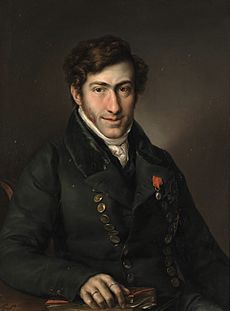
King Ferdinand VII had no children for many years. It was expected that his brother, Infante Carlos, would become king. Infante Carlos was very religious and conservative. Francisco de Paula supported his brother's political views, even if his own were more moderate. But his energetic wife, Luisa Carlotta, often pulled him into political struggles.
Luisa Carlotta was very interested in government matters. She wanted to prevent Don Carlos from becoming King. When King Ferdinand VII's third wife died in 1829, Luisa Carlotta convinced the King to marry her sister, Maria Christina of the Two Sicilies. They married in December 1829. Ferdinand VII and Maria Christina had two daughters. Their eldest daughter, Isabella, became the heir to the throne, thanks largely to Luisa Carlotta. Don Carlos and his family did not agree with this change and had to leave Spain. Ferdinand VII died in 1833.
When three-year-old Isabella II of Spain became queen, her mother, Queen Maria Christina, became regent. Francisco de Paula was disappointed that he was not included in the new government. Maria Christina secretly married a royal guard sergeant. Luisa Carlotta argued with her sister about this marriage. Soon, Francisco and his wife began to plot against the regent. Spain entered a civil war (1833-1839) as Don Carlos tried to take power.
Maria Christina stayed in power with the help of moderate politicians. She did not trust her ambitious sister. In 1837, when Francisco wanted a place in the senate, Maria Christina refused. This made the sisters enemies. For the next five years, Francisco de Paula and his wife worked against Maria Christina. Their actions were so disruptive that Maria Christina ordered Francisco and his family to leave Spain.
Exile and Return to Spain

In spring 1838, Infante Francisco de Paula, his wife, and their children went into exile in France. They were welcomed at the court of Louis Philippe, King of the French. His wife, Queen Maria Amelia, was Luisa Carlotta's aunt.
Meanwhile, in Spain, General Espartero became prime minister. He was a hero for winning against the Carlists in 1839. He soon became like a dictator. He forced Queen Maria Christina to resign as regent and sent her to exile in France in October 1840. Maria Christina's fall from power allowed Infante Francisco de Paula to return to Spain.
Back in Spain, Francisco de Paula and Luisa Carlotta first settled in Burgos. Espartero did not let them come to the capital. Later, he allowed them to live in Madrid, but not in the Royal Palace. The couple hoped to influence the Queen. They wanted to marry Isabella II and her sister, Infanta Luisa Fernanda, to their sons, Francisco de Asis and Enrique. When they tried to pressure Espartero, he sent them to Zaragoza in August 1842.
In Zaragoza, the Infante and his wife became leaders of the opposition to Espartero's government. In November, Francisco's supporters tried to overthrow the government. When the plan was discovered, Espartero expelled the Infante and his wife from Spain again. But their new exile was short. In July 1843, a military uprising and a conspiracy overthrew the regency. Queen Isabella was declared old enough to rule, and Espartero went into exile.
Infante Francisco returned to Madrid with his family. They lived in their own home, the Palace of San Juan. On January 29, 1844, Luisa Carlotta died suddenly from measles at age 39. Francisco de Paula remained a widower. He still wanted to marry his nieces to his two sons. Under pressure from French diplomats, Queen Isabella married her cousin, Francisco de Asis, in October 1846.
Later Years
When his son, Francisco de Asis, became king consort on October 10, 1846, Francisco de Paula's importance at court grew. Queen Isabella II liked him. One of his daughters, Infanta Josepha, became the Queen's best friend. However, the marriage between his son and niece was not happy. In 1849, Infante Francisco de Paula tried to help them reconcile. He sided with the Queen. But because he also suggested a new government, the current government exiled him from Spain. In 1850, he was allowed to return.
At age 58, Francisco de Paula married again on December 19, 1852, in Madrid. His second wife was Teresa de Arredondo y Ramirez de Arellano. She was much younger than him. They had a son, Ricardo María de Arredondo, born a week after their wedding. This child was not allowed to use the Bourbon family name. Queen Isabella II gave him the title Duke of San Ricardo in 1864.
His second marriage lasted twelve years and was a happy one. Francisco de Paula praised his wife's devotion to him. They lived a quiet life at the Palace of San Juan. Don Francisco de Paula often attended court events, but always without his wife. Teresa died on December 29, 1863. Their eleven-year-old son, Ricardo María, was cared for by his maternal grandmother.
Infante Francisco de Paula died of colon cancer on August 13, 1865. He was buried at the Escorial, as was proper for someone of his royal rank.
Marriages and Children
Francisco de Paula married twice.
His first wife was his niece Princess Luisa Carlotta of Naples and Sicily. They married on June 12, 1819, in Madrid. They had eleven children:
- Francisco de Asis de Borbón, Infante of Spain, Duke of Cádiz (1820–1821)
- Isabel de Borbón, Infanta of Spain (1821–1897); married Count Ignaz Gurowski
- Francisco de Asis de Borbón, Duke of Cádiz, King-Consort of Spain (1822–1902); husband of Queen Isabella II
- Enrique de Borbón, Duke of Seville (1823–1870); married Elena de Castellvi y Shelly-Fernandez de Cordova
- Luisa de Borbón, Infanta of Spain (1824–1900); married José Maria Osorio de Moscoso, Duque de Sessa
- Duarte Felipe de Borbón, Infante of Spain (1826–1830)
- Josefina de Borbón, Infanta of Spain (1827–1910); married José Güell y Rente
- Teresa de Borbón, Infanta of Spain (1828–1829)
- Fernando de Borbón, Infante of Spain (1832–1854)
- Maria Cristina de Borbón, Infanta of Spain (1833–1902); married Infante Sebastian of Portugal and Spain
- Amelia de Borbón, Infanta of Spain (1834–1905); married Prince Adalbert of Bavaria
Infante Francisco de Paula married Teresa de Arredondo y Ramirez de Arellano on December 19, 1852. They had one son:
- Ricardo María de Arredondo (1852–1872), Duke of San Ricardo. He died young and unmarried.
Honors and Awards
 France: Knight of the Order of the Holy Spirit (1816)
France: Knight of the Order of the Holy Spirit (1816) Austria: Grand Cross of the Order of St. Stephen (1818)
Austria: Grand Cross of the Order of St. Stephen (1818)
Heraldry
- Heraldry of Francisco de Paula of Spain
See also
 In Spanish: Francisco de Paula de Borbón para niños
In Spanish: Francisco de Paula de Borbón para niños


